Our editors independently select these products. Making a purchase through our links may earn Well+Good a commission
This Mediterranean Bean and Veggie Soup Is So Nutrient-Rich, Experts Are Calling It ‘Longevity Stew’
See how to make a delicious Ikarian Longevity Stew, a black-eyed peas recipe enjoyed in the Blue Zone of Ikaria, Greece.

For many people in the U.S., black-eyed peas are the star of the dinner table on New Year’s Day. (Maybe 2022 will bring more good luck if we all collectively eat our share of ’em?) But the rest of the year, they’re put on the metaphorical back burner.
Experts in This Article
Blue Zones expert and author of The Blue Zones Secrets for Longer Living
According to the U.S. Dry Bean Council, the most popular beans in the country are pinto, navy, Great Northern, red kidney, and black beans. Black-eyed peas? Not so much. (And yes, despite their name, BEPs are technically a bean.) You know where they are more popular? Ikaria, Greece, a Blue Zone—aka longevity hot spot—where people regularly live to be over 100 and in good health.
Dan Buettner is the founder of Blue Zones, an organization that helps Americans live longer, healthier, and happier lives based on insight from the five Blue Zone regions. In his new book, The Blue Zones Challenge ($14), he shares ways to integrate Blue Zones-inspired ways of life into your daily routine—including many recipes to cook up at home. One such recipe is an Ikarian Longevity Stew and the main ingredient is, you guessed it, black-eyed peas.
“Black-eyed peas are a great way to get beans in your diet and beans reign supreme in Blue Zones,” Buettner says. “They’re the cornerstone of every longevity diet in the world.” In general, Buettner says people in Blue Zones eat four times the amount of beans as people in the U.S., a dietary habit that could add an extra four years to your life. Beans are a staple in every single Blue Zone, and in Ikaria, black-eyed peas are especially popular.
But BEPs aren’t the only ingredient in the stew linked to longevity. In fact, every single ingredient in it is full of nutritional value. Here’s what else is in the stew: extra-virgin olive oil, red onion, garlic, fennel, tomatoes, bay leaves, dill, and a pinch of salt. Combined, they make a meal that’s full of plant-protein, fiber, antioxidants, and healthy fats. Buettner pointedly calls out the olive oil in the soup as an ingredient that shouldn’t be skipped. “Olive oil consumption increases good cholesterol and lowers bad cholesterol,” he says. “In Ikaria, we found that for middle-aged people, about six tablespoons of olive oil daily seemed to cut the risk of dying in half.” That’s major!
Watch the video below to learn more about the benefits of olive oil:
While this black-eyed peas recipe serves as a nutrient-packed dinner, Buettner says that’s not the only time it makes a great meal. “I like to make a large pot at the beginning of the week and will eat it for breakfast. It’s a great way to start the day off on the right foot,” he says. In the U.S., we may be used to sweet, often sugar-filled breakfasts, but in Blue Zones, savory morning meals are the norm.
Get the black-eyed peas recipe below, excerpted from Buettner’s new book. Feel free to add in other vegetables you have on hand too—it will only enhance the nutritional benefits of this longevity-supporting stew.
Ikarian longevity stew
Makes 4 servings
Ingredients
1/2 cup extra-virgin olive oil, divided1 large red onion, finely chopped4 garlic cloves, finely chopped1 fennel bulb, chopped1 cup (8 oz.) dried black-eyed peas (or 15 oz. *canned)1 large, firm ripe tomato, finely chopped2 tsp tomato paste, diluted in 1/4 cup water2 bay leaves1 bunch dill, finely choppedSalt to taste
1. Heat a quarter cup of the olive oil over medium heat and add the onion, garlic, and fennel bulb. Cook, stirring occasionally, until soft, about 12 minutes. Add the black-eyed peas and toss to coat in the oil.
2. Add the tomato, tomato paste, and enough water to cover the beans by about one inch. Add the bay leaves. Bring to a boil, reduce the heat, and simmer until the black-eyed peas are about halfway cooked. Check after 40 minutes, but cooking may take over an hour.
3. Add the chopped dill and season with salt.
4. Continue cooking until the black-eyed peas are tender. Remove the bay leaves, stir in the remaining olive oil, and serve.
*For dried peas, cover with water, bring to a boil, boil for one minute, remove from the heat, cover, and let sit for one hour. Drain, rinse, and use.
Get more healthy recipe ideas from around the world in Well+Good’s Cook With Us Facebook group.
Sign Up for Our Daily Newsletter
Get all the latest in wellness, trends, food, fitness, beauty, and more delivered right to your inbox.
Got it, you've been added to our email list.










